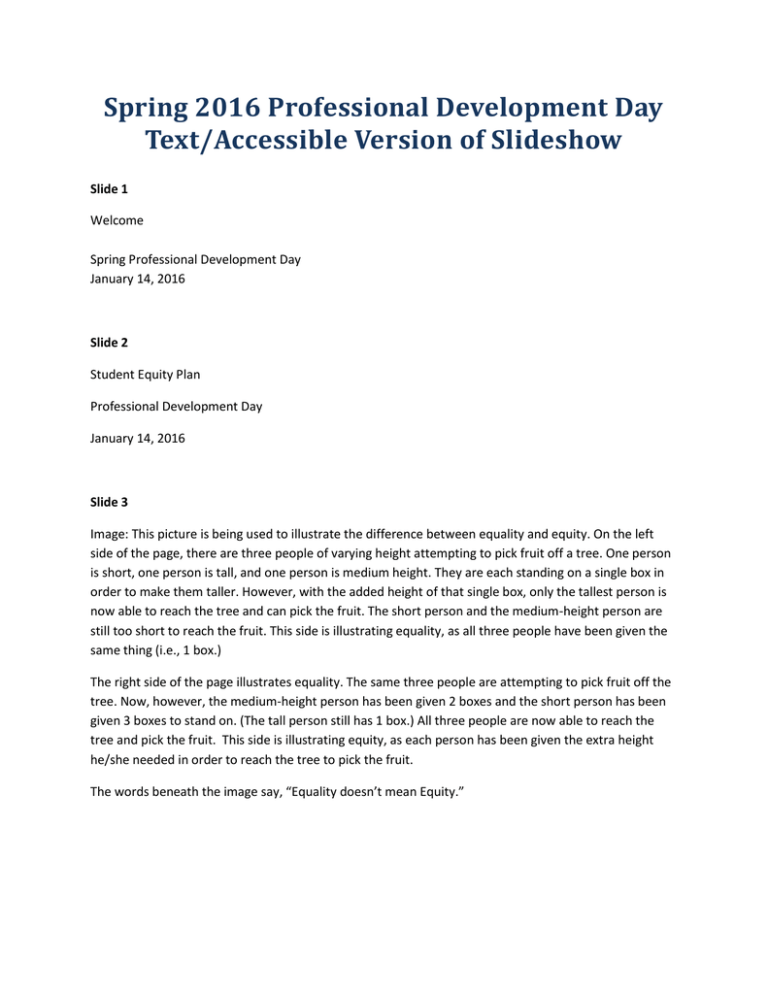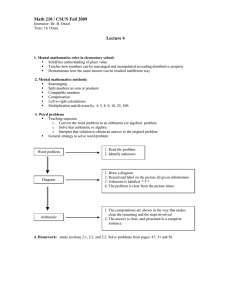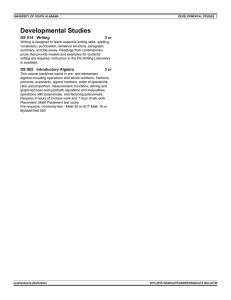Spring '16 PD Day Presentation (accessible Word doc)
advertisement

Spring 2016 Professional Development Day Text/Accessible Version of Slideshow Slide 1 Welcome Spring Professional Development Day January 14, 2016 Slide 2 Student Equity Plan Professional Development Day January 14, 2016 Slide 3 Image: This picture is being used to illustrate the difference between equality and equity. On the left side of the page, there are three people of varying height attempting to pick fruit off a tree. One person is short, one person is tall, and one person is medium height. They are each standing on a single box in order to make them taller. However, with the added height of that single box, only the tallest person is now able to reach the tree and can pick the fruit. The short person and the medium-height person are still too short to reach the fruit. This side is illustrating equality, as all three people have been given the same thing (i.e., 1 box.) The right side of the page illustrates equality. The same three people are attempting to pick fruit off the tree. Now, however, the medium-height person has been given 2 boxes and the short person has been given 3 boxes to stand on. (The tall person still has 1 box.) All three people are now able to reach the tree and pick the fruit. This side is illustrating equity, as each person has been given the extra height he/she needed in order to reach the tree to pick the fruit. The words beneath the image say, “Equality doesn’t mean Equity.” Slide 4 Title: Equity Plan Outline Chart Name: Planning Top-level bubble: Planning, Process, and Collaboration. Second-level bubble: Coordinating Programs Disabled Student Programs and Services (DSPS) Extended Opportunity Programs and Services (EOPS) and Special Services Math, Engineering, Sscience Achievement (MESA), Puente and Middle College High School Programs Student Success and Support Program (SSSP) Programs for foster youth Programs for veterans California Work Opportunity and Responsibility to Kids (CalWORKs) Student Financial Aid Administration, Board Financial Assistance Program (BFAP) Basic Skills Initiative (BSI) Slide 5 Title: Success Indicators Top-level bubble: The success indicators are: Access Course Completion ESL and Basic Skills Completion Degree And Certificate Completion Transfer Secondary bubble: Success Indicator Components 1. 2. 3. 4. 5. Campus-Based Research (DATA) Goals Activities Funding Evaluation Additional Secondary bubble: Racial / Ethnic Groups American Indian or Alaska Native Black or African American Hispanic or Latino Native Hawaiian or other Pacific Islander Asian White More than one race Additional Secondary Bubble: Characteristics Males Females Veterans Current or former foster youth Students with disabilities Low-income students Slide 6 Funding Categories Outreach Student Equity Coordination/Planning Instructional Support Activities Student Services or other Categorical Program Curriculum/Course Development or Adaptation Direct Student Support Research and Evaluation Professional Development Slide 7 [Note: The following graph, as well as the other graphs included here, should be parsable by a screen reader. If it is not parsable by your screen reader, or if you need a text-only descriptive version, please contact Elana at eazose@elcamino.edu.] Graph title: Data – Course Completion ECC, Fall 2014 90% 80% 70% 60% 50% 40% 30% 20% 10% 0% 9.58% 9.24% -3.79% 90.00% 80.00% -2.75% 70.00% -10.07% -8.63% 60.00% 50.00% 40.00% 30.00% 20.00% 10.00% 0.00% Percentage of courses passed (A, B, C, or credit) out of the courses students enrolled in on census day Average Pass Rate Slide 8 Chart title: Data – Course Completion ECC: Courses Lost Student Group Equity Gap (%) Equity Gap Multiply # courses enrolled on census day Number of courses “lost” (decimal) African American -10.07 -0.1007 X 7,287 734 American Indian/ Alaska Native -3.79 -0.0379 X 68 2.6 Native Hawaiian or Pacific Islander -8.63 -0.0863 X 289 25 Hispanic or Latino -2.75 -0.0275 X 27,088 745 Slide 9 Graph title: Data – Basic Skills Course Completion ECC 70.00% 70.00% 15.90% 12.20% 13.80% 60.00% 60.00% -0.20% 50.00% 40.00% 50.00% -9.40% -16.10% 30.00% -17.70% 40.00% 30.00% 20.00% 20.00% 10.00% 10.00% 0.00% Completion Rate Average Completion Rate 0.00% Slide 10 Title: Plan Organization at ECC The chart shows the ‘Student Equity Program’ being divided into 3 segments: Segment 1 – Student Equity Support Promoting Collaborations between focused programs: i.e., Veterans, Foster Youth, Project Success, Puente, etc. Success Indicators: ESL/Basic Skills Segment 2 – Professional Development Work with the Professional Development office and Faculty Development Committee to schedule ongoing development in areas affecting equity. Success Indicators: Degree/Certificate Completion; Transfer/Access Segment 3 – Across Curriculum Interventions Promoting traditional student support activities: i.e., tutoring, Supplemental instruction, etc. Success Indicator: Course Completion Slide 11 Graph title: Data – Course Completion Compton; Fall 2014 90% 20.00% 80% 9.80% 3.30% -3.20% -2.00% 70% 60% -6.90% -19.50% 50% -21.00% 40% 30% 20% 10% 0% Percentage of courses passed (A, B, C, or credit) out of the courses students enrolled in on census day Average Pass Rate Slide 12 Chart title: Data – Course Completion Compton: Courses Lost Student Group Equity Gap (%) Equity Gap Multiply # courses enrolled on census day Number of courses “lost” (decimal) -6.90 -0.0690 X 12,228 843 -19.50 -0.1950 X 37 7.2 -21.00 -0.2100 X 252 53 -16.60 -0.1660 X 388 64 African American American Indian/ Alaska Native Pacific Islander Foster Youth Slide 13 Graph title: 100% 90% 80% 70% 60% 50% 40% 30% 20% 10% 0% Data – Basic Skills Course Completion Compton 45.50% 22.40% 7.90% -4.00% -8.60% -10.30% -19.10% -21.20% Completion Rate Average Completion Rate Slide 14 Some Proposed Activities Implement embedded class tutoring in courses that traditionally have low success rates. Redesign in-class tutoring program for developmental writing courses to improve success and retention. Employee development in cultural awareness, intergroup dialogue, syllabus preparation, etc. Slide 15 Some Proposed Activities, continued Implement a Bridge English Program to accelerate pathways to transfer-level courses. Create peer mentor programs to improve student engagement. Develop diagnostic tests for each Math course that would be utilized to develop student success strategies. Slide 16 Budget Overview El Camino 2014-15 budget: $1,044,414 2015-16 budget: $2,112,177 Compton Center 2014-15 budget: $401,975 2015-16 budget: $821,379 Slide 17 Project Highlights Addressing Disproportionate Impact in Behavioral and Social Sciences Courses – Jason Suárez A Pathway Toward Equity in Developmental Math – Arturo Martinez and Lars Kjeseth Slide 18 [Note: Slides 18-26 are from Jason Suarez’s presentation.] Addressing Disproportionate Impact in Behavioral and Social Sciences Courses Spring 2016 Professional Development Day Image: The logo for SER – Student Equity Re-envisioned Slide 19 The BSS student equity challenge Table title: BSS Fall 2014-Spring 2015 Disaggregated Data Demographic # enrollment % enrollment D, F, NP, W % courses not passed African-American 4,104 15% 1,660 40% Asian 4,066 15% 695 17% Latino 14,492 52% 4,591 32% Pacific Islander 137 0% 62 45% White 3,566 13% 310 27% Slide 20 How can BSS contribute to student equity? Historically, the focus has primarily been on college readiness programs and interventions. Image: A pyramid made up of 4 triangles. The top triangle is Student Programs. The bottom three triangles are Student Services, Institutional Response, and College Readiness Courses. Slide 21 Title: Current trends explored 1. Give Students a Compass National initiative Advances liberal learning and underserved student success 2. Conferences/Institutes 3CSN Southern California Equity Summit Threshold Concepts Wicked Problems Leadership Institute 3. High Impact Practices/Learning Theory Learning Communities Affective and Experiential Learning Slide 22 BSS pilot approach Student equity is addressed by changing practices in the classroom and redesigning curriculum. Image: A pyramid made up of 4 triangles. The top triangle is Faculty Training. The bottom three triangles are Learning Community, Integration, and High Impact Practices. Slide 23 Faculty training Student Equity Re-envisioned Workshops From a Deficit-minded to an Equity-Minded Framework Threshold Concepts and Student Bottlenecks “Re-mapping” General Education Affective and Experiential Learning Slide 24 Theme-based learning community Foundational - Interest - Disproportionate Impact Fall 2016 theme – Social Problems Human Development 10: Strategies for Creating Success in College and in Life Ethnic Studies 1: Introduction to Ethnic Studies History 101: United States History to 1877 Slide 25 High impact practices Infusion into course design Threshold Concepts: discipline-based thinking Service Learning: integrate community service/instruction Signature Project: research on student-defined social problem PASS Mentors: peers assisting students with course content Student Services: Counseling/Career /Transfer Slide 26 To learn more visit http://eccser.org Jason R. Suárez Instructor of History Behavioral and Social Sciences Division jsuarez@elcamino.edu El Camino College Image: The logo for SER – Student Equity Re-envisioned Slide 27 [The following slides are from the final presentation] A Pathway Toward Equity in Developmental Math Lars Kjeseth & Art Martinez Slide 28 Proven strategies for closing equity gaps in developmental education: 1. Program Redesign (Acceleration) 2. Assessment / Placement Reform 3. Co-requisites / Mainstreaming Slide 29 Proven strategies for closing equity gaps in developmental education: 1. Program Redesign (Acceleration) Design new pathways, which move students more quickly into transfer-level English and mathematics courses in a way that prepares students for success in their chosen area of study. Slide 30 Title: 1. Program Redesign (Acceleration) The Traditional Developmental Mathematics Program... A 2008 - 2010 ECC tracking study of first-time arithmetic students yielded abysmal developmental math completion rates. Diagram description: The traditional developmental mathematics program is a sequence of four courses: arithmetic, pre-algebra, elementary algebra, and intermediate algebra. The diagram on this slide lists these four levels, starting with arithmetic at the top and progressing to intermediate algebra at the bottom, with arrows between each level. Slide 31 [Note: the following 6 slides have the same title – Developmental Mathematics Tracking Study] Students who first attempted arithmetic in Fall 2008 Image description: The 918 students who first attempted arithmetic in Fall 2008 are represented in the figure by 918 randomly scattered small blue diamonds. Slide 32 Students who passed arithmetic Image description: After two years, 492 students from the original 918 students had passed arithmetic. These students are represented in a figure where only 492 of the blue diamonds appearing in the box on the previous slide remain. Slide 33 Students who passed arithmetic and pre-algebra Image description: After two years, 292 students from the original 918 students had passed arithmetic and pre-algebra. These students are represented in a figure where only 292 of the blue diamonds appearing in the box on the previous slide remain. Slide 34 Students who passed arithmetic , pre-algebra, and elementary algebra Image description: After two years, 135 students from the original 918 students had passed arithmetic, pre-algebra, and elementary algebra. These students are represented in a figure where only 135 of the blue diamonds appearing in the box on the previous slide remain. Slide 35 Students who passed arithmetic , pre-algebra, and elementary algebra, and intermediate algebra Image description: After two years, 50 students from the original 918 students had passed arithmetic, pre-algebra, elementary algebra, and intermediate algebra. These students are represented in a figure where only 50 of the blue diamonds appearing in the box on the previous slide remain. Slide 36 Students who completed Developmental Math 50 Students out of 918 = 5%. Unacceptable! Image description: This slide summarizes slides 31 – 35, emphasizing the fact that only 5% of the 918 students who started in Fall 2008 finished developmental mathematics after two years. The figure has the 918 diamonds as in slide 32, but 50 of them are red and the rest are blue. Slide 37 Flowchart description: The traditional developmental mathematics pathway is the arithmetic – prealgebra – elementary algebra – intermediate algebra sequence of courses (these 4 courses appear in text bubbles to the right on the slide). The new developmental mathematics pathways are created by the introduction of two new courses, “BAM” and “GEA” (these acronyms appear on the left-hand side of the slide). GEA is a course one level below transfer that points to General Education Transfer-Level Mathematics and is a prerequisite for all non-STEM/non-Business entry-level transfer-level mathematics courses. GEA is open to any student qualified to take elementary algebra and in the diagram is at the same level as intermediate algebra. BAM, open to any student but recommended for students placing below elementary algebra, is an entry level course with three levels (A, B, and C), which create the possibility for any student to advance to Elementary Algebra or GEA if she passes Levels A and B, or to Intermediate Algebra if she passes Levels A, B, and C. Hence, BAM has lines pointing to Elementary Algebra, Intermediate Algebra, and GEA in the diagram. Intermediate algebra for STEM/Business points to all transfer-level mathematics and is a prerequisite for all entry-level transfer-level mathematics courses. Slide 38 [Note: the following 7 slides have the same title and subtitle – ECC Acceleration Results 2011 – 2014 Improved completion rates for all students at all levels, but equity gaps persist.] On this and the next 7 slides, there is a two-way table. The body of the table contains four rows and four columns. The headers for the rows are the following categories: All Students, African-Americans, Latino/Latina, and White (non-Hispanic). The four columns all contain 3-yr developmental mathematic completion rates (in percentages). The first column contains the data for all levels of developmental mathematics pre-reforms and is based on three cohorts prior to Spring 2011. The next three columns contain the data that was collected post-reforms. The first of these columns is again for all levels of developmental mathematics (post-reform) and based on three cohorts after Fall 2011. The next column breaks out those students from these three cohorts that started in arithmetic or pre-algebra. The last column breaks out those students from these three cohorts that started in BAM. On this slide, we highlight the fact that 29% of all students starting at all levels in these three cohorts prior to Spring 2011 (pre-reforms) completed developmental mathematics after 3 years. Slide 39 On this slide, we compare the 29% pre-reform developmental completion rate (for all students starting at all levels) with the 41% post-reform completion rate (for all students starting at all levels). Slide 40 On this slide, we break out the pre-reform 3-yr developmental completion rates(for all students at all levels) by African-American (13%, Latino/Latina (29%), and White (non-Hispanic) (41%). Slide 41 On this slide, we compare the pre-reform and post-reform 3-yr developmental completion rates (for all students at all levels) by African-American (13% pre-reform to 24% post-reform), Latino/Latina (29% prereform to 39% post-reform), and White (non-Hispanic) (41% pre-reform to 59% post-reform). Slide 42 On this slide, we focus again on all students starting at all levels, seeing again the 41% 3-yr developmental completion rate. In the next slide we will break out the students starting in arithmetic or pre-algebra and the students starting in BAM. Slide 43 On this slide, we see that among all students starting in arithmetic or pre-algebra 13% completed developmental math within three years and that 41% of students starting in BAM completed developmental math within three years. Slide 44 On this slide, we see that among all students starting in arithmetic or pre-algebra, the Latino/Latina (9%) and White (non-Hispanic) (11%) groups have completion rates below but near the average for all students (13%). However, the African-American group has a considerably lower completion rate (3%). Slide 45 On this slide, we see that among all students starting in BAM, the Latino/Latina (46%) and White (nonHispanic) (40%) groups have completion rates near or above the average for all students (41%). AfricanAmericans have a completion rate of 22%, well below the average of 41%, but still a great improvement over the completion rate for African-American students staring in arithmetic or pre-algebra. Indeed, all race/ethnic groups see considerable improvement in developmental math completion rates by starting in BAM rather than arithmetic or pre-algebra. Slide 46 [Note: The next 3 slides all have the same title - Why ECC Acceleration Works] In the next three slides, we point out features of BAM and GEA (ECC Acceleration) that contribute to its success, comparing these to the six characteristics the RP Group says contribute to student success. The circular diagram contains the six attributes (Focused, Nurtured, Engaged, Connected, Valued, and Directed) with lines connect these attributes to each other, suggesting how these characteristics are all interdependent. The next two slides have the details. Slide 47 The right half of the diagram from the previous slide (containing the Focused, Nurtured and Engaged attributes) are lined up with the three examples given on the page: • Focused: Shorter pathways to transfer-level allow students to remain motivated to succeed. • Nurtured: Affective domain activities inspire students to persevere. • Engaged: Students grapple with activities that emphasize critical thinking in authentic problems. Slide 48 The left half of the diagram from the slide two before this one (containing the Directed, Valued and Connected attributes) are lined up with the three examples given on the page: Directed: These courses have clear and high expectations. Students are accountable for meeting these standards. Valued: Students’ previous knowledge is honored and leveraged in the course. Connected: Frequent one-on-one conversations between instructors and students about progress and goals. Slide 49 Have a great semester! Image: ECC logo


